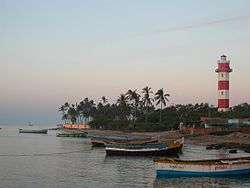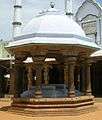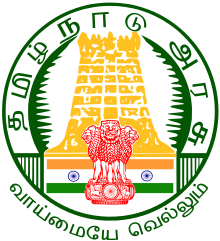Kilakarai
Kilakarai (alternatively spelled Kilakkarai or Keelakarai) is a municipality in Ramanathapuram district in the Indian state of Tamil Nadu. As of 2011, the town had a population of 38,355. Kilakarai is one of the Taluka in Ramanathapuram District.
Kilakarai Kutty Singapore | |
|---|---|
historical port town,
Keelai Municipality,Taluka | |
 | |
 Kilakarai Location in Tamil Nadu, India | |
| Coordinates: 9.23135°N 78.7844°E | |
| Country | |
| State | Tamil Nadu |
| District | Ramanathapuram |
| Taluka | Kilakarai |
| Government | |
| • Type | Second Grade Municipality |
| • Body | Municipality of kilakarai |
| Area | |
| • Total | 2.45 km2 (0.95 sq mi) |
| Area rank | 5 |
| Elevation | 17 m (56 ft) |
| Population (2016) | |
| • Total | 38,355 |
| • Rank | 2 |
| • Density | 16,000/km2 (41,000/sq mi) |
| Demonym(s) | Kilakaraian |
| Languages | |
| • Official | Tamil |
| Time zone | UTC+5:30 (IST) |
| PIN | 623 517 |
| Telephone code | 91 4567 |
| Vehicle registration | TN 65 |
| Distance from Chennai | 558 kilometres (347 mi) S |
| Distance from Bengaluru | 539 kilometres (335 mi) S |
| Distance from Madurai | 132 kilometres (82 mi) E |
| Distance from Ramanathapuram | 18 kilometres (11 mi) S |
| Distance from Coimbatore | 365 kilometres (227 mi) W |
| Distance from Tuticorin | 121 kilometres (75 mi) N |
| Distance from Adirampattinam | 152 kilometres (94 mi) S |
| Climate | BSh (Köppen) |
| Precipitation | 909 millimetres (35.8 in) |
| Avg. summer temperature | 30 °C (86 °F) |
| Avg. winter temperature | 25 °C (77 °F) |
History
Kilakarai is a coastal town and a port, located in the southern Tamil Nadu. It was a flourishing seaport and a gateway to places as far as Madurai until the early 20th century. The famous pearl belt known as the Gulf of Mannar in the Bay of Bengal is dotted with small islands Appa Tivu, Nallathanni Theevu, Shuli Tivu, Uppu Tanni Tivu, Talari Tivu and Musal Tivu. The coastal line of Kilakarai is formed by a series of small bays and finest coral reefs sheltering the town from the perils of the ocean. It was also called as "Quilicare",[1] kirkari, Sembi Nadu, Korkai, Powthira Manicka Pattinam,[2] "Kelikkarai", "Ninathaan mudithaan pattinam", "Seppi Nadu", "lebbat pattan" (pattan mentioned in voyages of Ibn Battuta & map displayed in Ibn Battuta Mall).
The prime occupations of the people were pearl, conch, sea trade and transport.[3] The mid-20th century saw a decline in the occupations of the people of Kilakarai, with the advent of the surface transport the Merchant Navies faded away and Kilakarai aka Killikare[4] ceased to be a harbour and port. The cultured pearl industry and the mindless dragnet fishing that destroyed the coral reefs, choked the once robust pearl trade or Muthu Salabam. The conch and coral industries declined due to new regulations and restrictions. Vattalappam is a famous dish during Eid and some special occasions
Kilakarai is renowned for its communal harmony. The majority of the population here is Muslim with people of other faith Hindu, Christians living together. The communal harmony that always existed is best exemplified by the famous Rameswaram Ramanathaswamy Temple and Jumma Pallivasal (Vallal Seethakathi is interred here) at Kilakarai, while the architecture is the same the workforce was provided by the erstwhile ruler Sethupathi of Ramnad and most of the materials for both the edifice were supplied by the Kilakarai merchant navies. The town is reminiscent of Spanish Moorish architecture and is located about 60 km south west of the temple town of Rameswaram.
It has the oldest mosque in India known as the kadakarai palli. It has a unique pre-Islamic heritage of more than 200 years. The Kilakarai Muslims or Kilakarai Moors form 80% of the population of Kilakarai. Ibnu Batutah once said in his travel notes "it's the place where most Arab settlers live and he was surprised to see them living as in Arab land".
The migration of the people after the decline of the marine trade and industry resulted in people exploring the other parts of the globe. Kilakarai has a large expatriate population and a high literacy rate.[5] This has enabled the people of Kilakarai to span the globe and become active merchants in the Middle and Far East, US and European markets.
Hameedia Primary School was started as a Madrasa in the year 1870, and gradually became a Thinnai Palli and became a registered School in 1938 due to the efforts of K.T.M. Hussain Sahib, fondly known as Haajiaar. This school is completing its sesquicentennial year (150th year) in 2020. The Hameedia Primary School Alumni Association - (HPSAA) consists of great stalwarts of Kilakarai including the founders of ETA, Crescent, Sathak Group and more than 100 institutions and business enterprises worldwide.
HPSAA is organising an Annual Reunion and Trade Fair annually on 25th & 26th of December, commencing its 150th year in 2019. Trade Fair and business summits, Job Fair, Free Medical Camp, Food Counters, Seminars and Talk shows for the benefit of the People of Kilakarai on a high note. Leading Brands, institutions, Business houses are expected to participate in this years edition.
Hameedia High School founded in 1940s beside the old Arabic Madrasa Aroosiya Thaika, was a catalyst to more graduates from Kilakarai. With the arrival of Mohamed Sathak Engineering College[6] and then the Thassim Beevi Abdul Kader College for Women[7] the number of graduates from this traditional town has seen a steady rise.
Kilakarai was constituted as a panchayat in the year 1885. As per G.O. No. 1157LN, date: 3 December 1885. It has since been upgraded as a Special Town Panchayat as per Director of Town Panchayat, Madras as per G.O. No. 1481/82/J5, Dated on 25 January 1982 and then upgraded as per G.O. No. 300 and 301 Dated on 24 August 2004 as a Third Grade Municipality.
The Muslim community of Kilakarai is philanthropic in nature, with assistance given to downtrodden sections of society, such as Dalits in Tirunelveli.
Sematiyar(saana moona keena) family was famous pearl merchandise in keelakarai in this family names are kept for local streets in keelakarai. [8]
Demographics
According to 2011 census, Keelakarai had a population of 38,355 with a sex-ratio of 948 females for every 1,000 males, much above the national average of 929.[9] A total of 4,391 were under the age of six, constituting 2,204 males and 2,187 females. Scheduled Castes and Scheduled Tribes accounted for 2.83% and .% of the population respectively. The average literacy of the town was 82.63%, compared to the national average of 72.99%.[9] The town had a total of : 7448 households. There were a total of 12,033 workers, comprising 29 cultivators, 47 main agricultural labourers, 165 in house hold industries, 10,765 other workers, 1,027 marginal workers, 15 marginal cultivators, 18 marginal agricultural labourers, 38 marginal workers in household industries and 956 other marginal workers.[10] As per the religious census of 2011, Keelakarai had 17.6% Hindus, 79.92% Muslims, 1.16% Christians, 0.01% Sikhs, 0.01% Jains, and 1.31% following other religions.[11]
Geography
Areas around Kilakarai
- Ramanathapuram
- Rameswaram
- Erwadi
- Kanjirangudi - known for Pakkirappa Dargah
- Thirppullani
- Thiru UthuiraKosa Mangai
- Saayal Kudi
- Periyapattinam
- Vannaan Kundu
- Mandapam
- Paampan Bridge
- Sikkal
- Sayalgudi
Educational institutions
Schools
- Hairathul Jalaliah Higher Secondary School – East street
- Magdoomiah High School – OJM Street
- Kannadi Vappa International School – Kanjirangudi
- Hameediah Matriculation Higher Secondary School – West Street
- Islamiah Matriculation Higher secondary school – South Street
- Islamiah High School – South Street
- Mohaideeniah Matriculation Higher secondary school – North street
- Sathakathun Jariyah Middle School – Middle Street
- Hameediyah Boys Higher Secondary School – Mulluvadi
- Hameediyah Girls Higher Secondary School – West Street
- Hameediah Primary School – West Street . founded in 1870
- Nooraniah Matriculation School – New Street
- Dheeniyah Matriculation Higher Secondary School – East Street
- Pearl Matriculation School – Kilakarai
- Al Bayyinah Matriculation School – East Street
- P.s.Subramanian Jayalakshmi Nadar Matriculation School - Kilakarai
Colleges
- Mohamed Sathak Engineering College
- Thassim Beevi Abdul Kader College for Women
- Syed Hameedha Arts and Science College
- Mohamed Sathak Polytechnic College
- Mohamed Sathak I.T.I (Industrial Training Institute)
- Arusiyyah Arabic College
- Syed Hameedha Arabic College
- Bukhari Aalim Arabic College
Photo gallery
 View of the Kilakarai Lighthouse from the dock
View of the Kilakarai Lighthouse from the dock View from the dock at sunrise
View from the dock at sunrise Interior of Odakarai Palli (masjid)
Interior of Odakarai Palli (masjid) Odakarai Palli (masjid) under conservation
Odakarai Palli (masjid) under conservation Masjid ul Jamiah
Masjid ul Jamiah Masjid ul Jamiah (3rd oldest masjid of Kilakarai)
Masjid ul Jamiah (3rd oldest masjid of Kilakarai) Masjid ul Jamiah
Masjid ul Jamiah Corridor in Masjid ul Jamiah
Corridor in Masjid ul Jamiah Interior of Masjid ul Jamiah
Interior of Masjid ul Jamiah Interior of Palaiya Jumma Palli or The Old Jumma Masjid of Kilakarai, the oldest masjid of India
Interior of Palaiya Jumma Palli or The Old Jumma Masjid of Kilakarai, the oldest masjid of India Amir ul Muminin Abu Baker Siddiq Palli (masjid)
Amir ul Muminin Abu Baker Siddiq Palli (masjid) Tombstone with Arabic & Tamil (Arwi) inscription (at The Old Jumma Masjid of Kilakarai)
Tombstone with Arabic & Tamil (Arwi) inscription (at The Old Jumma Masjid of Kilakarai) Kulangarai Appa Palli (masjid), East Street, Kilakkarai
Kulangarai Appa Palli (masjid), East Street, Kilakkarai Interior of Kulangarai Appa Palli (masjid), East Street, Kilakarai
Interior of Kulangarai Appa Palli (masjid), East Street, Kilakarai Typical street
Typical street
Notes
- Barbosa, Duarte; Dames, Mansel Longworth (1989). The Book of Duarte Barbosa: An Account of the Countries Bordering on the Indian Ocean and Their Inhabitants. ISBN 9788120604513.
- http://puthu.thinnai.com/?p=20958
- Kunz, G.F.; Stevenson, C.H. (2013). The Book of the Pearl: Its History, Art, Science and Industry. Dover Jewelry and Metalwork. Dover Publications. p. 113. ISBN 978-0-486-14274-6. Retrieved 14 May 2019.
- mohammad suhaib, on 17 August 2012, said (17 August 2012). "Photo of Kilakarai in an ancient map". Panoramio. Archived from the original on 18 January 2018. Retrieved 6 June 2013.CS1 maint: multiple names: authors list (link)
- "Ramanathapuram District Population Census 2011, Tamil Nadu literacy sex ratio and density". Census2011.co.in. Archived from the original on 23 March 2012. Retrieved 6 June 2013.
- "Archived copy". Archived from the original on 11 August 2011. Retrieved 17 August 2011.CS1 maint: archived copy as title (link)
- "Thassim Beevi Abdul Kader College For Women". Thassim.in. 3 April 2013. Archived from the original on 24 September 2011. Retrieved 6 June 2013.
- https://www.indiatoday.in/magazine/religion/story/19810731-tamil-nadu-witnesses-mass-conversion-of-harijans-to-islam-773097-2013-11-15
- "Census Info 2011 Final population totals". Office of The Registrar General and Census Commissioner, Ministry of Home Affairs, Government of India. 2013. Archived from the original on 13 November 2013. Retrieved 26 January 2014.
- "Census Info 2011 Final population totals – Keelakarai". Office of The Registrar General and Census Commissioner, Ministry of Home Affairs, Government of India. 2013. Archived from the original on 24 September 2015. Retrieved 26 January 2014.
- "Population By Religious Community – Tamil Nadu" (XLS). Office of The Registrar General and Census Commissioner, Ministry of Home Affairs, Government of India. 2011. Archived from the original on 13 September 2015. Retrieved 13 September 2015.
References
- "Tamil Nadu's Kilakarai – the birth place of world famous Indian conches". onlypunjab.com. Archived from the original on 23 May 2007.
- "An oasis in a desert A district bridging the gulf". The Hindu. 7 August 2005.
| Wikimedia Commons has media related to Kilakarai. |
